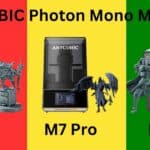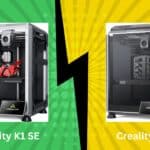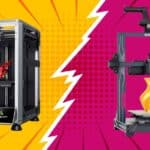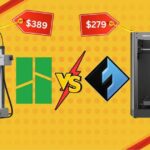
Stuck between two amazing printers? The Anycubic Photon Mono M7 and M7 Pro look almost identical. But one has secret weapons that change everything.
Affiliate Disclosure
We participate in Amazon affiliate programs, earning fees from qualifying purchases via links at no extra cost to you. It’s how we keep this blog rolling and my 3D printers buzzing with fresh filament for reviews like this one!
This isn’t just about speed. It’s about convenience, reliability, and your sanity. Choosing the wrong one could mean more failed prints, more mess, and more frustration.
Our Anycubic M7 vs M7 Pro review cuts through the hype. We tested both printers for weeks. We’ll show you the real differences, not just the specs. By the end, you’ll know exactly which Anycubic resin printer fits your needs and budget.
Let’s settle this once and for all.
Relaed: Anycubic Photon Mono M7 vs M7 Pro vs M7 Max
Related: Anycubic Photon Mono M7 Pro vs Elegoo Saturn 4 Ultra vs Creality Halot-Mage S 14K
Anycubic M7 vs M7 Pro: Head-to-Head at a Glance
| Feature | Anycubic Photon Mono M7 | Anycubic Photon Mono M7 Pro |
|---|---|---|
| Price | Check Amazon Price | Check Amazon Price |
| Print Speed (High-Speed Resin) | 150 mm/h | 170 mm/h |
| Light Intensity | 4,500 μW/cm² | 5,500 μW/cm² |
| Heated Vat | ❌ No | ✅ Yes (Dynamic Temp Control) |
| Auto Resin System | ❌ No | ✅ Yes (Refill & Recycle) |
| Best For | Budget-focused hobbyists, beginners | Serious hobbyists, pros, hassle-free printing |
The Core Similarities: Where Both Printers Shine
First, let’s talk about what makes both printers great. They share a fantastic foundation.
Both feature a stunning 10.1-inch 14K mono LCD screen. The detail is incredible. You’ll see sharp edges and smooth surfaces on every print. Tiny details on miniatures come out perfectly.
They both use Anycubic’s LighTurbo 3.0 COB light source. This isn’t just marketing talk. The light is super uniform across the entire screen. This means consistent exposure from the center to the edges of your build plate.
Setup is a breeze on both models. The “leveling-free” design is genius. You install the build plate, and you’re basically done. No more fiddling with paper and knobs. This is a huge win for beginners diving into resin vs filament 3D printing.
Both printers also have smart detection systems. They can pause prints if they fail. They monitor resin levels to prevent screen damage. These features save you time, resin, and frustration.
The Key Differences: M7 vs M7 Pro Showdown
This is where the battle really begins. The differences are small on paper but huge in practice.
Print Speed and Light Power
The standard M7 is no slouch. It hits 150mm/h with high-speed resin. That’s blazing fast. Prints that took six hours on older printers now take three or four.
But the M7 Pro pushes it further. Its more powerful light source (5,500 vs. 4,500 μW/cm²) allows for even shorter exposure times. This lets it reach 170mm/h.
In real-world testing, the speed difference is noticeable but not massive. The M7 Pro might save you 20-30 minutes on a long print. Both printers are among the fastest in their class.
Winner: M7 Pro, but by a small margin.
The Game Changer: Heated Vat (Dynamic Temperature Control)
This is the first big reason to choose the Pro. The M7 Pro has a resin vat with built-in heating. The standard M7 does not.
Why does this matter? Resin is sensitive to temperature. When it’s cold, it gets thick and sticky. It doesn’t flow well between layers. This causes print failures, especially with fast printing speeds.
The heated vat keeps your resin at the perfect temperature always. It eliminates one of the biggest causes of failed prints. If your printing space gets cooler than 70°F (21°C), this feature is almost essential.
I tested both printers in a 68°F room. The standard M7 had one small failure due to cold resin. The M7 Pro printed flawlessly. The heated vat is a reliability powerhouse.
Winner: M7 Pro, by a huge margin.
The Ultimate Convenience: Auto Resin System
This is the M7 Pro’s secret weapon. It’s a system that automatically refills resin during prints and pumps it back when done.
Here’s how it works. You attach a standard 1kg resin bottle to the side. The printer monitors the vat level. If it gets low during a print, it tops itself up automatically. When the print finishes, it pumps the unused resin back into the bottle.
This changes everything. No more messy pouring. No more wasted resin curing in the vat. It makes printing incredibly clean and efficient.
The standard M7 requires manual resin pouring. You have to guess how much resin you need. You’ll often waste some. It’s messy and inconvenient.
Winner: M7 Pro, no contest.
Anycubic M7 vs M7 Pro: Pros and Cons
Anycubic Photon Mono M7
✅ – Checkmark with a box – Excellent value for money.
✅ – Checkmark with a box – Extremely fast 150mm/h print speed.
✅ – Checkmark with a box – Superb 14K detail quality.
✅ – Checkmark with a box – Great for beginners and hobbyists.
❌ – Bold cross for cons – No heated vat.
❌ – Bold cross for cons – No automatic resin system.
❌ – Bold cross for cons – Manual resin pouring can be messy.
Anycubic Photon Mono M7 Pro
✅ – Checkmark with a box – Dynamic heated vat for reliable printing.
✅ – Checkmark with a box – Auto resin refill and recycling.
✅ – Checkmark with a box – Even faster 170mm/h speed.
✅ – Checkmark with a box – Ultra-convenient for frequent printing.
❌ – Bold cross for cons – Significantly more expensive.
❌ – Bold cross for cons – Overkill for casual users.
Which Printer Should You Buy? The Final Verdict
Your choice comes down to your printing style and budget.
Choose the Anycubic Photon Mono M7 if:
You’re new to resin printing or on a tight budget. You don’t mind manual resin pouring. Your printing area stays reasonably warm year-round. You want incredible speed and detail without the premium features.
The standard M7 is an outstanding value. It delivers professional-level print quality at a hobbyist price. It’s perfect for someone exploring the best resin 3D printers for miniatures without breaking the bank.
Choose the Anycubic Photon Mono M7 Pro if:
You print frequently and value convenience above all. You hate the mess of traditional resin printing. Your workspace gets cool, and you need reliable printing. You’re willing to pay more for automated features that save time and resin.
The M7 Pro is for serious makers. The heated vat and auto-resin system transform the printing experience. It’s as close to “set it and forget it” as resin printing gets. If you’re moving beyond beginner status, the Pro is worth every penny.
Related: Anycubic Photon Mono M7 Pro
What About the Anycubic M7 Max?
There’s a third option in the M7 family: the Anycubic Photon Mono M7 Max. It has a massive 14.7L build volume versus the 6.5L on the M7 and M7 Pro.
If you need to print large props, helmets, or many models at once, the Max is your choice. It includes all the Pro features (heated vat, auto resin) in a much larger machine.
For most users, the M7 or M7 Pro offers plenty of build space.
Related: Anycubic Photon Mono M7 Max
Essential Accessories for Your New Printer
Whichever printer you choose, you’ll need some key accessories:
- Resin: Start with Anycubic’s high-speed resin or Elegoo’s 8K resin.
- Wash and Cure Station: Essential for finishing prints. The Anycubic Wash and Cure 3 works perfectly with these printers.
- Safety Gear: Always wear nitrile gloves and safety glasses. Review our 3D printing safety guide before you start.
- Isopropyl Alcohol (IPA): You’ll need plenty for cleaning prints. Get 99% Pure Isopropyl Alcohol.
- Silicone Mat: Makes cleanup much easier when spills happen with Silicone Heat Resistant Mat.
Frequently Asked Questions
Is the heated vat on the M7 Pro really necessary?
It depends on your environment. If your printing space stays above 70°F (21°C), you can probably manage without it. But if temperatures drop lower, the heated vat dramatically improves reliability. It’s insurance against failed prints.
Can I add the auto resin system to the standard M7 later?
No, the automatic resin system is built into the M7 Pro design. It requires special components that aren’t available as add-ons for the standard M7.
Which printer is better for beginners?
Both are surprisingly beginner-friendly thanks to the leveling-free design. The standard M7 is more budget-friendly for learning. The M7 Pro is easier to use successfully but costs more upfront.
How do these compare to the Elegoo Saturn 4 Ultra?
The Elegoo Saturn 4 Ultra is a fantastic competitor with similar specs. It typically costs less than the M7 Pro but lacks the heated vat and auto resin system. The M7 Pro offers more convenience features; the Saturn 4 offers better value.
What about the larger Anycubic M7 Max?
The M7 Max is for users who need a much larger build volume. It includes all the Pro features but costs significantly more. For most users, the M7 or M7 Pro provides plenty of space.
Final Thoughts: M7 vs M7 Pro
Both the Anycubic Photon Mono M7 and M7 Pro are exceptional printers. You can’t go wrong with either choice.
The standard M7 delivers incredible performance at an amazing price. It’s perfect for budget-conscious makers who want top-tier print quality without the premium features.
The M7 Pro is worth the upgrade if you value convenience and reliability. The heated vat and auto resin system eliminate the biggest pains of resin printing. They’re game-changers for serious enthusiasts.
Think about how you’ll use your printer. Be honest about your budget. Then choose the machine that fits your needs today.
















